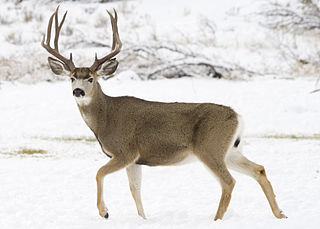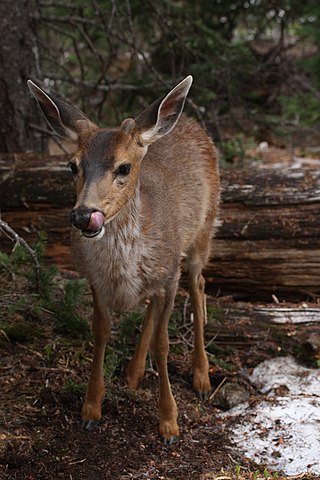
The northern bobwhite, also known as the Virginia quail or bobwhite quail, is a ground-dwelling bird native to Canada, the United States, Mexico, and Cuba, with introduced populations elsewhere in the Caribbean, Europe, and Asia. It is a member of the group of species known as New World quail (Odontophoridae). They were initially placed with the Old World quail in the pheasant family (Phasianidae), but are not particularly closely related. The name "bobwhite" is an onomatopoeic derivation from its characteristic whistling call. Despite its secretive nature, the northern bobwhite is one of the most familiar quails in eastern North America, because it is frequently the only quail in its range. Habitat degradation has contributed to the northern bobwhite population in eastern North America declining by roughly 85% from 1966 to 2014. This population decline is apparently range-wide and continuing.

The white-tailed deer, also known commonly as the whitetail and the Virginia deer, is a medium-sized species of deer native to North America, Central America, and South America as far south as Peru and Bolivia, where it predominately inhabits high mountain terrains of the Andes. It has also been introduced to New Zealand, all the Greater Antilles in the Caribbean, and some countries in Europe, such as the Czech Republic, Finland, France, Germany, Romania and Serbia. In the Americas, it is the most widely distributed wild ungulate.

The mule deer is a deer indigenous to western North America; it is named for its ears, which are large like those of the mule. Two subspecies of mule deer are grouped into the black-tailed deer.

Two forms of black-tailed deer or blacktail deer that occupy coastal woodlands in the Pacific Northwest of North America are subspecies of the mule deer. They have sometimes been treated as a species, but virtually all recent authorities maintain they are subspecies.

Attwater Prairie Chicken National Wildlife Refuge is a federally protected refugium encompassing one of the largest remnants of coastal prairie habitat remaining in southeast Texas, United States, and home to one of the last populations of critically endangered Attwater's prairie chickens, a ground-dwelling grouse of the coastal prairie ecosystem.

The Key deer is an endangered subspecies of the white-tailed deer that lives only in the Florida Keys. It is the smallest extant North American deer species.

The Columbian white-tailed deer is one of the several subspecies of white-tailed deer in North America. It is a member of the Cervidae (deer) family, which includes mule deer, elk, moose, caribou, and the black-tailed deer that live nearby.

The National Key Deer Refuge is a 8,542-acre (34.57 km2) National Wildlife Refuge located on Big Pine Key and No Name Key in the Florida Keys in Monroe County, Florida.

The Key Largo woodrat, a subspecies of the eastern woodrat, is a medium-sized rat found on less than 2,000 acres of the northern area of Key Largo, Florida, in the United States. It is currently on the United States Fish and Wildlife Service list of endangered species. Only 6500 animals were thought to remain in North Key Largo in the late 1980s.
Fern Cave National Wildlife Refuge is a 199-acre (0.8 km2) National Wildlife Refuge located in northeastern Alabama, near Paint Rock, Alabama in Jackson County.

The California mule deer is a subspecies of mule deer whose range covers much of the state of California.
Epizootic hemorrhagic disease (EHD) is a hemorrhagic disease of white-tailed deer caused by an infection of a virus from the genus Orbivirus subsequently called Epizootic hemorrhagic disease virus (EHDV). It is an infectious, and sometimes fatal, virus that is characterized by extensive hemorrhages, and is found throughout the United States. Large-scale outbreaks in wild ruminants affect livestock and the production industry. EHD has been found in some domestic ruminants and many species of deer including white-tailed deer, mule deer, elk, and pronghorn antelope. Seropositive black-tailed deer, fallow deer, red deer, wapiti, and roe deer have also been found, which essentially means that they were exposed to the disease at some time in the past but may not be involved in transmission. Outbreaks of EHD have been reported in cattle, although they rarely develop disease or die. Sheep may develop clinical signs, but this is also rare. EHD is often called bluetongue, but this is incorrect. Bluetongue virus is closely related to EHDV, and has similar clinical signs, but it is a different disease. Bluetongue is a serious disease in cattle, as well as other ruminants, and can have a significant effect on international trade. Testing at animal health laboratories is necessary to distinguish between the viruses that cause bluetongue and EHD.

The wildlife of Cambodia is very diverse with at least 162 mammal species, 600 bird species, 176 reptile species, 900 freshwater fish species, 670 invertebrate species, and more than 3000 plant species. A single protected area, Keo Seima Wildlife Sanctuary, is known to support more than 950 total species, including 75 species that are listed as globally threatened on the IUCN Red List. An unknown amount of species remains to be described by science, especially the insect group of butterflies and moths, collectively known as lepidopterans.
The Blackbeard Island National Wildlife Refuge is a 5,618 acres (2,274 ha) National Wildlife Refuge located in McIntosh county in Georgia. The refuge was established to provide a nature and forest preserve for aesthetic and conservation purposes.
The Cedros Island mule deer is a subspecies of mule deer found only on Cedros Island off the coast of Baja California. Only about 50 individuals remain, with no captive population. Its behavior is similar to that of other subspecies of mule deer. The subspecies is threatened by feral dogs and poaching.
Hilton Head white-tailed deer are a subspecies of white-tailed deer indigenous to Hilton Head Island in South Carolina. The deer live in a mainly suburban environment and have developed home range areas on the island.

The Gulf of St. Lawrence lowland forests are a temperate broadleaf and mixed forest ecoregion of Eastern Canada, as defined by the World Wildlife Fund (WWF) categorization system.

The Alberta Mountain forests are a temperate coniferous forests ecoregion of Western Canada, as defined by the World Wildlife Fund (WWF) categorization system.

The North Central Rockies forests is a temperate coniferous forest ecoregion of Canada and the United States. This region overlaps in large part with the North American inland temperate rainforest and gets more rain on average than the South Central Rockies forests and is notable for containing the only inland populations of many species from the Pacific coast.
Bavispe Flora and Fauna Protection Area is a protected area in the state of Sonora in northwestern Mexico.















